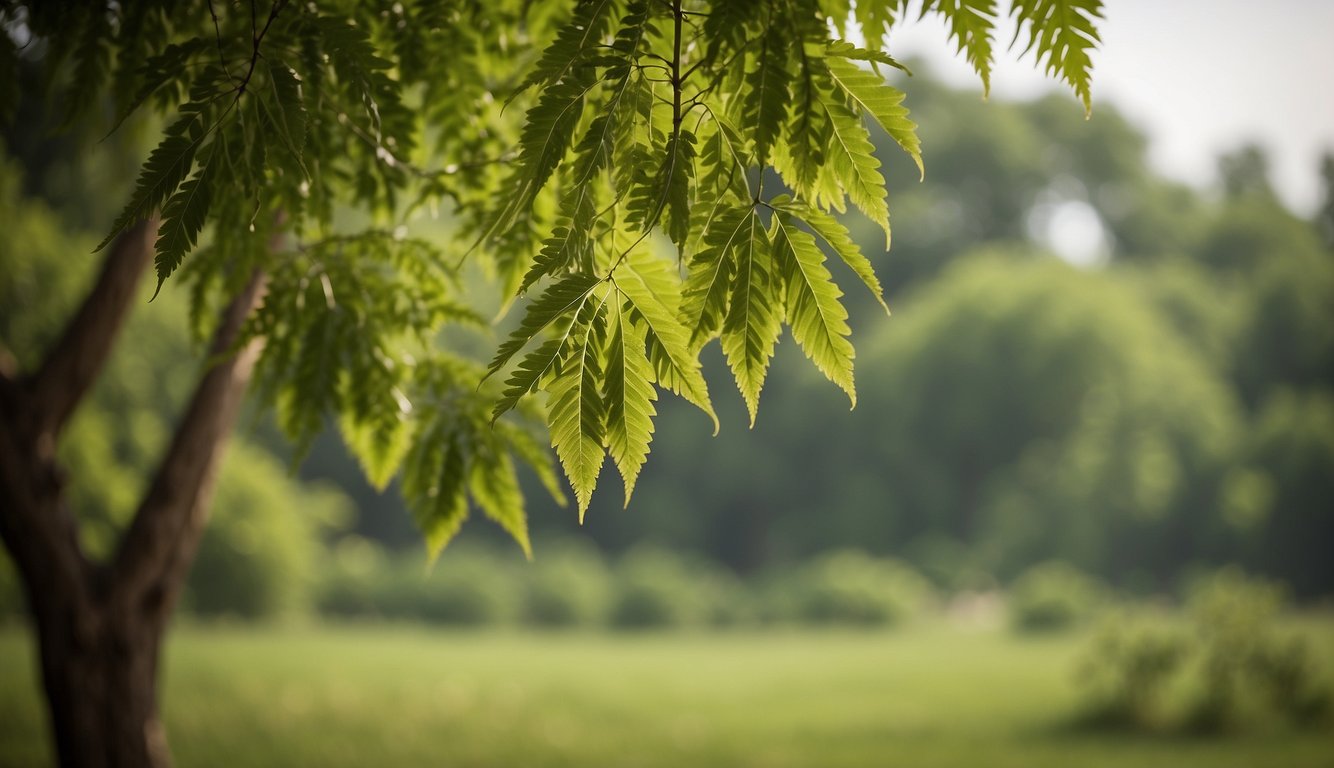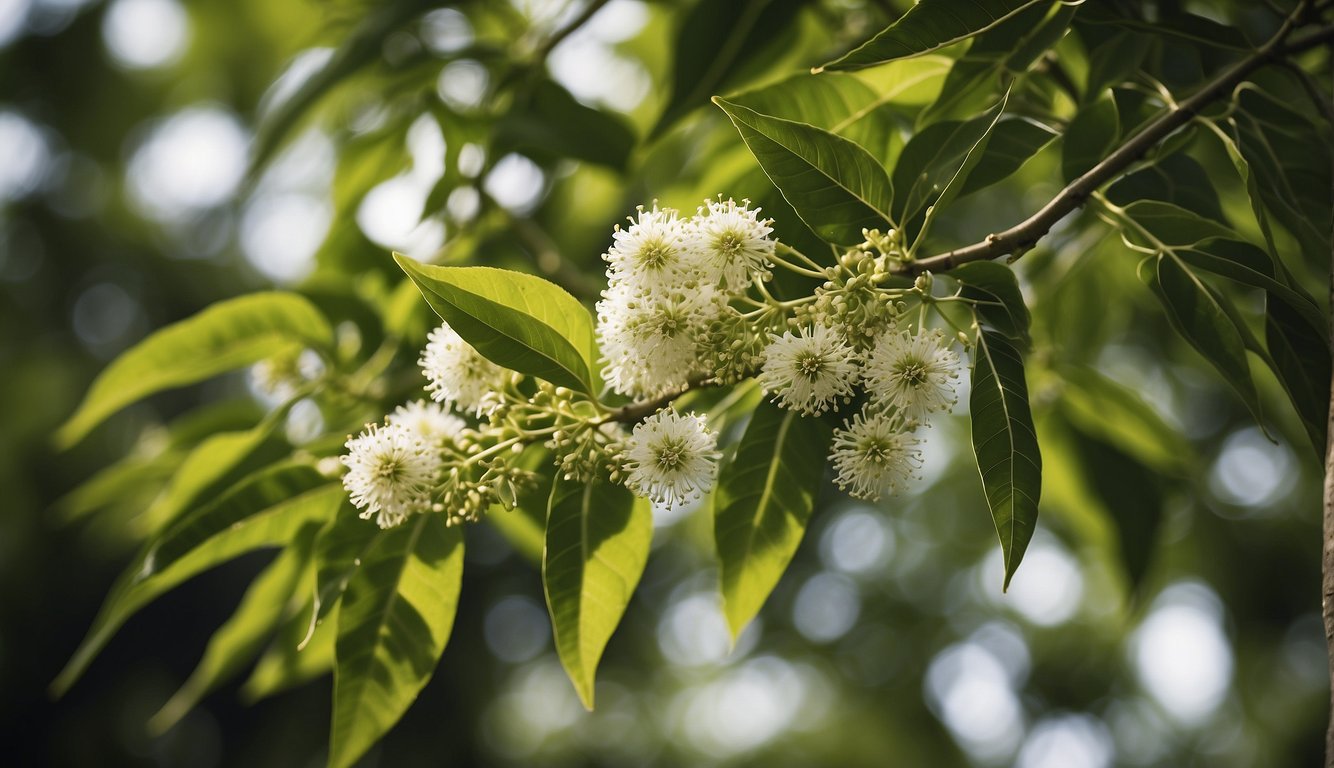TheHerbProf.com is a treasure trove of knowledge for those interested in natural healing and herbal remedies. The website is run by Paul Johnston MD. A naturopathic who has not only received extensive education in the field but also has personal experience in self-healing.
What are the top neem tree benefits? The neem tree, also known as Azadirachta indica, is a versatile plant that has been used for centuries in traditional medicine. Native to the Indian subcontinent, the neem tree is known for its numerous medicinal properties. From its leaves to its bark, every part of the neem tree has been used to treat a variety of ailments.
One of the most well-known benefits of the neem tree is its antibacterial and antifungal properties. Studies have shown that neem extracts can be effective against a wide range of bacteria and fungi, including those that are resistant to antibiotics. This makes neem an excellent natural alternative to traditional antibiotics.
In addition to its antibacterial and antifungal properties, neem also has anti-inflammatory and analgesic effects. This makes it a popular remedy for a variety of conditions, including arthritis, skin conditions, and digestive issues. With its many health benefits, the neem tree is truly a remarkable plant with a long history of use in traditional medicine.
Neem Tree Benefits, Historical Significance and Origin

As someone who has been fascinated by natural remedies for a long time, I have always been intrigued by the neem tree and its many benefits. In this section, I will explore the historical significance and origin of the neem tree.
Neem in Ancient Medicine
Neem has been used in Ayurvedic medicine for centuries. Ayurveda is a traditional system of medicine that originated in India over 5000 years ago. The neem tree, also known as Azadirachta indica, is deeply woven into the fabric of Ayurvedic medicine. It has been used to treat a wide range of ailments, from skin conditions to digestive issues.
One of the reasons why neem is so highly regarded in Ayurvedic medicine is because of its antibacterial and antifungal properties. These properties make it an effective treatment for a variety of skin conditions, such as acne and eczema.
Neem Tree Benefits Geographical Spread
The neem tree is native to India, and it has been an important part of Indian culture and tradition for centuries. It is often referred to as the “village pharmacy” because of its many medicinal properties.
Over time, the neem tree has spread to other parts of the world, including Africa, the Caribbean, and South and Central America. Today, it is grown in many countries around the world, and it is used in a variety of products, from cosmetics to insecticides.
The neem tree has a rich history and a wide range of traditional uses. Its antibacterial and antifungal properties make it an effective treatment for a variety of ailments, and it has been an important part of Ayurvedic medicine for centuries.
Neem Tree Benefits and Botanical Characteristics

Neem (Azadirachta indica) is a fast-growing evergreen tree that belongs to the mahogany family. As a medicinal plant, neem has been used for centuries in Ayurvedic and folk medicine. The tree is native to the Indian subcontinent and dry areas of South Asia, but it is now widely cultivated in tropical and subtropical regions around the world.
Neem Tree Benefits Physical Description
Neem trees can reach up to 15-30 meters (49-98 feet) in height, with a spread of 10-15 meters (33-49 feet). The tree has a straight trunk with a diameter of up to 2 meters (6.6 feet) and a dense, spreading crown. The leaves of the neem tree are alternate, pinnate, and 20-40 cm (7.9-15.7 inches) long. Each leaf has 20-31 leaflets, which are 3-8 cm (1.2-3.1 inches) long and 1.5-3 cm (0.59-1.18 inches) wide. The leaves are dark green, shiny, and have a bitter taste.
The neem tree produces small, white, fragrant flowers that are about 5 mm (0.20 inches) in diameter. The flowers are arranged in axillary panicles, which are 15-25 cm (5.9-9.8 inches) long. The tree also produces a small, olive-like fruit that is 1.4-2 cm (0.55-0.79 inches) long and 1.0-1.5 cm (0.39-0.59 inches) wide. The fruit contains a seed, which is about 1 cm (0.39 inches) long and 0.5 cm (0.20 inches) wide.
Growth Conditions
Neem trees are well adapted to hot and dry climates and can grow in a wide range of soils, including sandy, loamy, and clayey soils. The tree prefers a pH range of 6.2-7.0 and can tolerate drought and high temperatures. However, neem trees do not tolerate frost, and young trees are susceptible to damage from strong winds.
The neem tree is a highly valued medicinal plant that has a wide range of uses. Its physical description and growth conditions make it a versatile tree that can thrive in various climates and soils.
Health Benefits – Neem Tree Benefits
As someone who has extensively researched the neem tree, I can confidently say that it has numerous health benefits. From skin care to anti-cancer potential, the neem tree has been used for centuries in traditional medicine for its healing properties.
Skin Care
Neem has been shown to be effective in treating various skin disorders such as acne, eczema, and psoriasis. The leaves of the neem tree contain anti-inflammatory properties that can help reduce redness and swelling associated with these conditions. Additionally, neem oil has been used to treat dry skin and reduce the appearance of wrinkles.
Dental Care
Neem has been used for centuries as a natural remedy for dental care. Its antibacterial properties make it effective in reducing plaque and preventing gingivitis. Neem oil is also effective in treating toothaches and gum infections.
Anti-Diabetic Effects
Studies have shown that neem can help regulate blood sugar levels in people with diabetes. The leaves of the neem tree contain compounds that can lower blood glucose levels and improve insulin sensitivity.
Immune System Support
Neem has been shown to have immune system support properties. It contains compounds that can stimulate the immune system and improve its function. Neem can also help fight off infections and diseases by boosting the body’s natural defenses.
Anti-Cancer Potential
Research has shown that neem has anti-cancer potential. The leaves of the neem tree contain compounds that can help prevent the growth and spread of cancer cells. Additionally, neem has antioxidant properties that can help protect the body against the damaging effects of free radicals.
The neem tree has numerous health benefits that make it a valuable addition to any natural medicine cabinet. Its anti-inflammatory, antibacterial, and immune system support properties make it effective in treating a variety of conditions.
Neem Tree Benefits, Therapeutic Compounds and Uses

As a medicinal plant, neem tree has been used for centuries to treat various ailments. This is due to the presence of several active compounds in neem that have therapeutic benefits. In this section, I will discuss some of the active compounds in neem and their uses.
Active Compounds in Neem
Neem contains several active compounds such as azadirachtin and limonoids that have antibacterial and antifungal properties. According to a study published in the Journal of Global Infectious Diseases, neem has been found to be effective against a wide range of bacteria and fungi [1]. These compounds help to prevent the growth of harmful microorganisms that can cause infections and other health problems.
Neem and Pain Relief
Neem has been found to have pain-relieving properties. According to a study published in the Journal of Ethnopharmacology, neem has been found to be effective in reducing pain and inflammation [2]. This makes neem a useful natural remedy for conditions such as arthritis, joint pain, and other inflammatory conditions.
Anti-Inflammatory and Antifungal Benefits
Neem has been found to have anti-inflammatory and antifungal benefits. According to a study published in the Journal of Inflammation Research, neem has been found to be effective in reducing inflammation [3]. This makes neem a useful natural remedy for conditions such as ulcers, infections, and other inflammatory conditions. Additionally, neem has been found to have antifungal properties that can help to treat fungal infections such as athlete’s foot and ringworm.
Neem tree has several active compounds that have therapeutic benefits. These compounds help to prevent the growth of harmful microorganisms, reduce pain and inflammation, and have antifungal properties. Neem is a useful natural remedy for a variety of health conditions and can be used in various forms such as neem oil, neem leaves, and neem bark extract.
[1] https://www.ncbi.nlm.nih.gov/pmc/articles/PMC4791507/ [2] https://www.ncbi.nlm.nih.gov/pmc/articles/PMC4791507/ [3] https://www.ncbi.nlm.nih.gov/pmc/articles/PMC7479161/
Neem Tree Benefits in Personal Care Products – Get Your Herbal Neem Leaf Here.

As a natural ingredient, neem is a popular choice in personal care products due to its various benefits. Here are some of the ways neem is used in personal care products:
Neem Oil Applications
Neem oil is a common ingredient in many personal care products. It is extracted from the seeds of the neem tree and has a wide range of applications. Neem oil is known for its antibacterial, antifungal, and anti-inflammatory properties, which make it useful in treating various skin conditions such as acne, eczema, and psoriasis. It is also used in hair care products to promote healthy hair growth and combat dandruff.
Oral Hygiene and Neem Tree Benefits
Neem is also used in oral hygiene products such as mouthwash and toothpaste. Neem leaf extract has been found to be effective in reducing plaque and gingivitis, making it a popular ingredient in natural toothpaste and mouthwash. Additionally, neem oil is a natural antiseptic and can help combat bad breath.
Neem-Based Cosmetics
Neem is a common ingredient in many cosmetics due to its moisturizing and anti-aging properties. It is often used in creams, lotions, and serums to promote healthy skin and reduce the appearance of fine lines and wrinkles. Neem is also a popular ingredient in natural soaps and shampoos, as it can help soothe dry, itchy skin and promote healthy hair growth.
Overall, neem is a versatile ingredient in personal care products, with a wide range of applications and benefits. Whether you are looking to combat acne, reduce plaque, or promote healthy hair growth, neem is a natural and effective ingredient to consider incorporating into your personal care routine.
Neem in Agriculture and Pest Control

As a natural pesticide, neem has been used for centuries in agriculture and pest control. Its effectiveness against pests and insects is due to the presence of azadirachtin, a compound found in the neem seed oil.
Neem as a Natural Pesticide
Neem seed oil is a natural pesticide that can be used to control a wide range of pests, including insects, mites, and nematodes. It is also effective in controlling fungal diseases in plants. The fatty acids in neem oil disrupt the life cycle of the pests, preventing them from reproducing and causing damage to the plants.
Effects on Pests and Insects
The use of neem in agriculture and pest control has been shown to have many benefits. Neem oil disrupts the feeding behavior of insects, making it difficult for them to feed and grow. It also interferes with the insect’s ability to molt, leading to their death. Neem oil has also been shown to have a growth inhibitory effect on pests, reducing their population and preventing further damage to crops.
In addition to its pest control properties, neem has been shown to have a positive effect on plant growth. The use of neem as a fertilizer has been shown to increase soil fertility and improve plant growth. The high levels of azadirachtin in neem cake granules make it an effective organic fertilizer and manure in farming and agriculture.
Overall, the use of neem in agriculture and pest control has many benefits. Its natural properties make it an effective alternative to synthetic pesticides, while its ability to improve soil fertility and plant growth make it a valuable addition to any farming or gardening practice.
Neem Tree Benefits, Cautions and Potential Side Effects

Neem has been used for centuries in traditional medicine, and it is generally considered safe when used in appropriate doses. However, it is important to be aware of potential side effects and cautions when using neem.
Neem Toxicity Concerns
While neem is generally safe, it is important to note that high doses of neem can be toxic. According to a source, consuming a supplement like neem may have potential side effects. These side effects may be common or severe. Due to lack of research, little is known about the safety of short-term or long-term use of neem.
Usage During Pregnancy
Neem should not be used during pregnancy as it may cause miscarriage or harm to the fetus. According to Healthline, neem may have contraceptive properties and should not be used by women who are trying to conceive.
Interactions with Medications
Neem may interact with certain medications, including those for diabetes, blood pressure, and immune system disorders. It is important to talk to a healthcare provider before using neem if you are taking any medications.
It is important to note that neem may also affect the liver. If you have liver disease or are taking medications that affect the liver, it is important to speak with a healthcare provider before using neem.
While neem has many potential health benefits, it is important to be aware of potential side effects and cautions when using neem. It is always a good idea to speak with a healthcare provider before using any new supplement or medication.
Neem Tree Benefits in Traditional and Alternative Practices

As a medicinal plant, the neem tree has been used in traditional and alternative practices for centuries. Its various parts, including the leaves, bark, flowers, and extracts, have been utilized in Ayurvedic medicine, home remedies, and other forms of alternative medicine.
Ayurvedic Uses of Neem
In Ayurvedic medicine, neem is considered a powerful herb that can help treat a wide range of health conditions. The tree’s bark, leaves, and flowers are often used to make powders, extracts, and other forms of medicine. According to Ayurvedic practitioners, neem can help purify the blood, boost the immune system, promote healthy skin, and support healthy digestion.
Neem is also used in Ayurveda to treat respiratory conditions, such as asthma and bronchitis. The tree’s leaves are believed to have anti-inflammatory and anti-bacterial properties, which can help alleviate symptoms associated with these conditions. Additionally, neem is used to treat skin conditions, such as eczema and psoriasis.
Neem Tree Benefits in Home Remedies
In addition to Ayurvedic medicine, neem is also used in various home remedies. For example, neem leaves can be boiled in water and used as a mouthwash to help treat gum disease and other oral health issues. The leaves can also be used to make a paste that can be applied to the skin to help treat acne, scars, and other skin conditions.
Neem oil is another common home remedy that is used to treat a variety of health conditions. The oil is extracted from the tree’s seeds and is believed to have anti-inflammatory and anti-bacterial properties. It can be used topically to help treat skin conditions, such as eczema and psoriasis, and can also be ingested to help treat digestive issues, such as constipation and diarrhea.
Overall, neem is a versatile plant that has been used in traditional and alternative practices for centuries. Its various parts, including the leaves, bark, flowers, and extracts, have been utilized in Ayurvedic medicine, home remedies, and other forms of alternative medicine.
Linking Neem Tree Benefits to TheHerbProf.com
Neem is a versatile herb with a multitude of health benefits, and at TheHerbProf.com, we’re all about exploring these benefits! Here’s how our website and this subject harmonize:
- Neem Narratives: We provide comprehensive information about neem, its medicinal properties, and its uses in herbal medicine.
- Herbal Highlights: Our site offers insights into how neem can be incorporated into your herbal regimen.
- Safety Measures: We guide you on how to use neem safely and effectively.
- Health and Wellness: Our focus is on promoting overall health and wellness, and neem plays a crucial role in this.
- Community Connection: Connect with others who are passionate about neem and share your experiences.
So, whether you’re a neem enthusiast or just starting your herbal journey, TheHerbProf.com is your trusted guide. Remember, stay curious and stay healthy!
References – Neem Tree Benefits
Little Herb Encyclopedia, by Jack Ritchason; N.D., Woodland Publishing Incorporated, 1995
The Ultimate Healing System, Course Manual, Copyright 1985, Don Lepore
Planetary Herbology, Michael Tierra, C.A., N.D., Lotus Press, 1988
Handbook of Medicinal Herbs, by James A. Duke, Pub. CRP Second Edition 2007
The Complete Medicinal Herbal, by Penelope Ody, Published by Dorling Kindersley
Before You Go – Check the Following Articles!
Frequently Asked Questions – Neem Tree Benefits

What are the advantages of using neem oil for hair care?
Neem oil has several benefits for hair care. It can help in treating dandruff, dry scalp, and other scalp infections. It also promotes hair growth and helps in keeping the hair healthy and shiny. Neem oil contains fatty acids and antioxidants that help in nourishing the hair and preventing hair breakage.
Which diseases can be treated with neem leaves?
Neem leaves have been used for centuries in traditional medicine to treat a variety of diseases. They have antifungal, antibacterial, and anti-inflammatory properties that make them effective in treating skin infections, fever, digestive disorders, and respiratory problems. Neem leaves are also known to have anti-cancer properties and can be used to prevent and treat certain types of cancer.
What are the medicinal properties of neem that are beneficial for health?
Neem has several medicinal properties that are beneficial for health. It is a natural detoxifier and can help in purifying the blood. It has anti-inflammatory and analgesic properties that make it effective in treating pain and inflammation. Neem is also known to have antifungal and antibacterial properties that help in fighting infections.
How does consuming boiled neem leaves water affect the body?
Consuming boiled neem leaves water can have several health benefits. It can help in purifying the blood, improving liver function, and boosting the immune system. It is also known to have anti-inflammatory properties that can help in reducing inflammation in the body. However, it is important to note that neem leaves water should be consumed in moderation as excessive consumption can have harmful effects.
Can neem leaves improve skin health, and if so, how?
Yes, neem leaves can improve skin health. They have antibacterial, antifungal, and anti-inflammatory properties that make them effective in treating acne, eczema, and other skin infections. Neem leaves also contain antioxidants that help in preventing premature aging and keeping the skin healthy and glowing.
Are there any known side effects associated with the use of neem leaves?
Although neem leaves have several health benefits, excessive consumption or use can have harmful effects. Neem leaves are known to lower blood sugar levels and should be avoided by people with diabetes. They can also cause liver damage if consumed in excessive amounts. Pregnant women should also avoid consuming neem leaves as it can cause miscarriage. It is important to consult a healthcare professional before using neem leaves for medicinal purposes.


